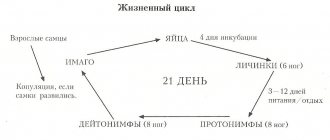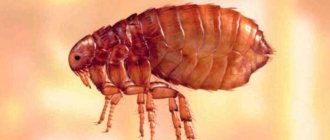Pets bring not only a lot of joy, but also a number of problems. Many cat owners have at least once wondered: how can they rid their pets of worms?
Helminths are very dangerous for cats, and if you do not start to fight the infestation, then in a particularly severe case of the disease the animal may even die.
What to do in such a situation? To get started, we recommend reading this article. This article describes in detail methods of controlling parasites. We also recommend that you consult a specialist. Read the article >>>
Routes of infection
Helminths are the causative agents of helminthiasis in humans and animals, which are worms of various species.
There are several ways to become infected with parasites. The first and most common is through the eggs of these worms, which can remain viable for a long time in the external environment.
In addition, raw fish and meat, unwashed vegetables are sources of infection with worms. The carriers of their eggs are flies, cockroaches and bedbugs, so worm eggs can end up on bread and cooked food if left uncovered.
Many are sure that their pets cannot become infected, because they do not leave the house. And how many infections that are waiting in the wings in the ground, grass, water, we ourselves bring home on our shoes!
Remember how curious animals, and especially kittens, always explore our shoes and then lick themselves - this is the source of infection. By the way, kittens can become infected with helminths through the milk of a nursing mother.
What do you think about the drug "Profender"?
Most owners think that tablets are a priori better, because... worms in the intestines, the tablet is sent there. “Profender” has been tested on hundreds of cats, starting with my own cat. There were several cases of misfires - this is acceptable because Any even super drug works with about 99% efficiency.
This drug is absorbed from the skin into the blood and kills Toxocara larvae, and then excreted with bile into the intestines and kills adults there. When using the drug, dead helminths will be excreted in the feces 2-3 days after using the drug. Those who use pyrantel are accustomed to the fact that helminths come out within the first day, and without waiting for the effect, they sometimes go to the store for a pill.
Types of worms in cats
Most of the helminths that infect animals pose a danger to human health, so we definitely need to figure out which worms can parasitize our furry pets and how to rid them of this danger.
Most often they are infected by nematodes (roundworms) and cestodes (tapeworms), less often by trematodes (fluke worms).
These parasites affect not only the intestines, but also the liver, gall bladder and even the lungs; some parasites can even penetrate the heart.
Nematodes are small round worms, the body length of which ranges from 2 mm to several centimeters, and if helminthiasis is severely advanced, then the parasites can reach 10 cm, in which case death is inevitable. If an animal is infected with worms, their eggs can be found in its feces.
The habitat of roundworms is the small intestine; their food is blood, which carries toxic products throughout the body that the worms secrete during their life processes.
Thus, they not only deprive the body of nutrients, which can lead to anemia, but also poison them with their toxic secretions.
Tapeworms have a flat appearance, the length of which can reach from 10 to 70 cm. Such worms have a body consisting of many segments, in each of which larvae develop.
Gradually, these segments containing the larvae separate and are excreted along with the feces. Upon careful examination of the cat, they can be found on the fur around the anus and in the feces; in appearance they resemble grains of rice. Since cats lick themselves, this can cause reinfection.
What can a dog become infected with when fed (raw) meat? And how can this be dangerous for humans?
By the word “meat” I mean, first of all, products of slaughterhouse origin, this includes pure meat, liver, and lungs. The fact is that, as a rule, if an animal is fed raw meat, then it is probably fed the rest. In general, you can specifically ask the owner about each type of product, but I don’t see much point in this.
The meat may contain Toxocara larvae, less commonly cestode larvae. Trichinosis is not of great importance for cats and dogs, and with trichinosis everything is more or less in order in terms of examination - pigs are checked, but cows and sheep do not need this. Since we cannot be completely confident in the quality assessment of the meat we purchase, the dog should receive its dose of praziquantel once every 3 months, regardless of whether it is urban or not.
From products of slaughterhouse origin you can get a complete set:
- from pigs - echinococcosis, alveococcosis, taeniasis;
- from cattle – echinococcosis, teniosis;
- from sheep - muscular coenurosis (dogs), echinococcosis, extremely rarely (!) alveococcosis (cats and dogs), teniasis;
- rabbits - alveococcosis, teniosis;
- And also linguatulosis, toxocariasis, etc....
Actually, when they came up with preventive deworming, it was aimed specifically at these “comrades”, because a person becomes an intermediate host, receiving the invasive origin from his animals - predators, which are usually the final hosts. A dog should receive its dose of praziquantel every 3 months, regardless of whether it is a city dweller or not.
. Echinococcosis and alveococcosis are diseases that are controlled by WHO and WSAVA.
Signs of infection
Evidence of helminthiasis is vomiting and rapid weight loss. This is a consequence of damage to the intestinal mucosa, as well as other organs of the animal.
All this, combined with toxic secretions, leads to weakened health of the animal, and in especially severe cases, to death due to blockage or rupture of the intestines.
A person can easily become infected even from a domestic cat. Their bodies are susceptible to infection by more than 82 types of worms, 32 of which can be transmitted to humans.
Most often, the transmission of parasites occurs due to insufficient hygiene rules. The routes of infection can be different, in particular through human skin or through fleas.
The invasion manifests itself with a number of symptoms depending on how many parasites and what helminths have proliferated in the animal’s body. If there are not many worms, then the infection may not manifest any symptoms at all.
Most often, helminthiasis is characterized by the following symptoms:
- diarrhea or constipation or their alternation;
- vomiting, and in case of severe damage - vomiting with blood;
- severe itching in the anus, which causes cats to rub this area on the floor;
- the appearance of individual segments or fragments of worms or whole worms in the feces or on the fur in the anal area;
- the appearance of blood or mucus in the stool;
- bloating of the abdomen, which becomes round;
- rapid weight loss;
- weak or, conversely, increased appetite;
- difficulty breathing and cough;
- hair loss;
- rapid fatigue;
- retarded growth and development in kittens;;
- on the mucous membranes – yellowness or pallor;
- In pregnant cats, worms can cause spontaneous miscarriage or premature birth.
In some cases, convulsions and paralysis of the hind limbs are possible.
Diagnostics
How to determine that a cat has helminthiasis and not some other disease, infectious or non-infectious, in which the same symptoms appear?
This is a very important question, because if you start treatment in an adult, and even more so in a kitten, who has picked up another infection, it can end in death. An accurate diagnosis can only be made by a veterinarian based on a stool analysis.
At the slightest suspicion that your pet has worms, collect her feces in a tightly closed jar (it should be clean and dry) and take it to the veterinarian for analysis (until this time, store it in the refrigerator). At the pharmacy you can buy a special jar for testing.
How to determine if a cat has worms?
How to quickly get rid of worms
It would be more accurate to formulate this question a little differently: not only “How to quickly get rid of worms in a cat/kitten,” but also how to do it correctly, because there have been cases when treatment ended in their death.
Before starting treatment, you need to determine which parasitic worm has infected your pet.
This requires laboratory analysis of stool in a veterinary clinic. Only then will the veterinarian be able to select the right medicine, since some drugs for roundworms will not work on tapeworms and vice versa.
It is clear that at home, trying to get rid of worms on your own and prescribing a certain drug to your pet, without knowing what kind of helminths they are, will be useless, and in some cases unsafe. It is strictly prohibited to use medications intended for treating people!
Some people hope for medications that can help get rid of almost all types of paraitis, especially since sometimes an animal is infected with several types of helminths at once.
However, this can only be done as prescribed by a veterinarian, otherwise the animal may be harmed due to the high toxicity of the drug, which sometimes causes intoxication.
You can also get rid of parasites at home. This is done:
- a single-component drug that specifically targets certain helminths;
- a complex drug with a wide spectrum of action aimed at several types of helminths.
Before this, the cat must be treated with flea treatment, as they are carriers of a number of helminths.
They can also be treated at home using tablets that are soluble in their food or drink, or suspensions. If there are small children in the house, then the use of anthelmintic sprays is not recommended due to the toxic substances they contain.
To completely get rid of parasites, it is very important to repeat the worming after 10 days to achieve maximum effect.
True, there are medicines that destroy parasites in 1 day, such as Profender. Pyrantel is one of the safest drugs that does not cause intoxication.
In general, the list of anthelmintic drugs is quite large: Panacur, Milbemax, Febtal, Canikquantel, Drontal, Polyvercan, Prazicide, Troncil K, Prazitel, suspension for kittens Dirofen, etc.
It is very important to purchase medications from a veterinary pharmacy. It is also important to pay attention to what breed you are purchasing the drug for: a kitten or an adult, otherwise the animal may die from an overdose. It is recommended to treat worms before vaccinations.
The most toxic drugs are those applied to the withers, so they are contraindicated for kittens and old or sick individuals. A pregnant cat should be given anthelmintics strictly according to the stage of pregnancy.
You can also remove worms using folk remedies such as tansy (in the form of a tincture) and wormwood (in the form of a decoction). Prevention with folk remedies is usually carried out once a season.
Garlic is an excellent anthelmintic, so it is worth accustoming your cat to it from a very early age by adding a small piece, crushed into a paste, to its food for a week.
How often should anthelmintics be used for dogs and cats?
1.
According to the WSAVA, dogs and cats are best dewormed quarterly.
2.
If your region is unfavorable for dirofilariasis, then during the flight of mosquitoes, monthly medications are used to prevent this disease (Stronghold, Advocate, Milbemax, etc.). It is possible to replace them with prolonged macrocyclic lactones, but we do not sell them yet.
3.
If the dog is a herding dog, then deworming with praziquantel-containing drugs once a month is advisable. (This figure has been confirmed many times in experiments). This is a matter of the safety of the health of the surrounding people and the herd, and not the health of the dog itself.
4.
Indoor cats, if they follow a diet without raw fish, products of slaughterhouse origin, mice and there are no walking animals (for example, dogs) in the house or other sources of fleas, can be dewormed once every 6 months. (this is my personal opinion), and sometimes even less often. This applies to adult animals, i.e. older than 8-12 months. This provision does not apply to puppies and kittens.
In this case, we are talking about “blind” prevention, when you do not know whether the animal is infected or not. If there is a specific diagnosis or a specific parasitological situation, then the frequency and drugs are selected individually.
How to get an animal to take medicine
It is most convenient to give a suspension. If you still choose tablets, then you need to crush them, stir, add a little water and put them into a syringe without a needle.
The cat will offer active resistance, so the easiest way is to wrap it in a blanket, so that only its head is outside, so as not to scratch it, press it towards you, unclench its jaws and inject liquid with a syringe.
Then clamp the animal's jaws and stroke its throat (this will provoke a swallowing reflex), and the medicine will reach its destination. Some people mix the crushed tablet with food, but in this case there is no guarantee that the entire dose will be eaten.
4-5 hours after taking the deworming remedy, it is necessary to give a sorbent: the dose is prescribed depending on the age and body weight of the animal (from 0.5 to 1.5 tablets). Coal can be replaced with enterosgel according to the instructions.
Make sure that the cat's intestines work; if this does not happen quickly, use a laxative syrup. This is necessary to completely get rid of dead worms and their decay products.
It is possible to defeat parasites!
Antiparasitic Complex® - Reliable and safe removal of parasites in 21 days!
- The composition includes only natural ingredients;
- Does not cause side effects;
- Absolutely safe;
- Protects the liver, heart, lungs, stomach, skin from parasites;
- Removes waste products of parasites from the body.
- Effectively destroys most types of helminths in 21 days.
There is now a preferential program for free packaging. Read expert opinion.
Read further:
How to get rid of roundworms at home using tablets and folk recipes
How to get rid of worms without pills using traditional medicine methods
How to quickly remove worms at home using medications and folk remedies
How to get rid of nits at home, traditional methods
Long worms in cats: main types, description and methods of treating parasites in cats
What worms can you get from a cat: a list of common cat worms
Ways to give the product to a kitten
The easiest way to give a medicine in the form of a suspension is to a kitten by pouring a sweet liquid into the animal’s mouth using a syringe without a needle. In addition, there are the following ways to feed your pet medicine:
- Dissolve the tablet in milk and inject using the same syringe.
- Crush the tablet and add to food.
- Add a whole tablet to dry food, and the kitten will eat everything without noticing the fraud.
- Open the animal's mouth, put the tablet on the tongue, close and lift the animal's muzzle up, while stroking its throat. This is a violent method and it is better to use it as a last resort if other methods do not work.











